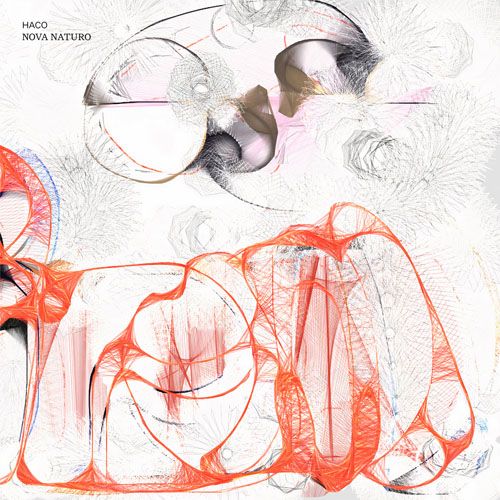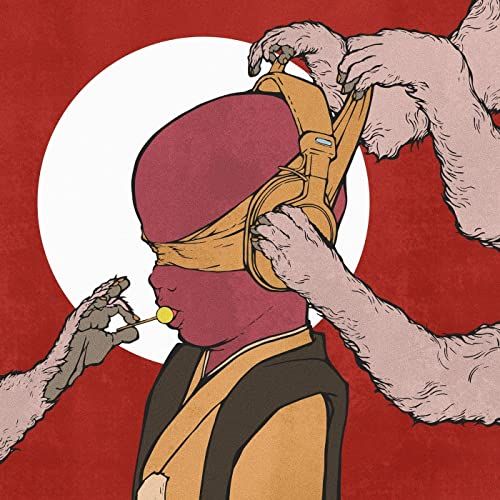
Glow Staff |December 19 2021
The Best Japanese Albums of 2021
Glow Staff
List
December 19 2021
The Best Japanese Albums of 2021
From immaculate folk pop to engulfing cloud rap, these were the Japanese albums from the last twelve months that shined the most.
In 2021, the world started to get back on its feet. But although the music scene was less down-and-out than in 2020, with continuing lockdowns, border closures and various restrictions on live performances, musicians still found themselves in precarious times.
Looser restrictions meant that Japanese musicians were able to more freely promote new albums with live shows both at home and abroad. Supporting physical releases with live gigs is a crucial part of the album release cycle, and in Japan, as Japanese artists slowly endorse streaming services – and while the royalties from such services remain so poor – live performances are more vital than ever.
Thanks to that all-important return to live shows, the year burst with releases delayed by the pandemic. We were fortunate in that The Glow’s second year saw such a full schedule of exceptional albums, EPs and mixtapes – and that, as a result, our year-end list is bigger and even more varied than before. Assembled and written with the help of our roster of writers, here are 26 of the best Japanese albums released in 2021.
26.
Odottebakari no Kuni: moana

The music of Kobe-heralding Odottebakari no Kuni mixes Japanese folk melodies with Western music like jazz, blues, country and psychedelic rock. Singer and guitarist Koji Shimotsu is influenced equally by Western rock like Lou Reed or Devendra Banhart as he is by Japanese folk/rock like Happy End or Yumi Arai. The songs for Odottebakari no Kuni’s 8th album moana were composed on the southern island of Okinawa. The band was looking for words and melodies with supernatural atmosphere while they enjoyed yoga or meditation, surrounded by the sea. - Toyokazu Mori
Listen: Spotify, Apple Music
25.
Sound’s Deli: Made In Tokyo Bang

Tokyo-based hip-hop collective Sound's Deli's debut Made In Tokyo Bang is more than its colourful, positive vibes. It’s a totally joyous listen, but the quartet also take things further; endorsing the beats and sampling techniques of trap while showing respect for the old school. They show a willingness to try new things and challenge prior conventions – but do so in an adept, technical way. The rapping by all members of Sound’s Deli is well-balanced, not too spirited or overenthusiastic, nor too loose; while the energetic microphone relays keep the listener on the edge of their seat. “GOODBYE”, the final track and a collaboration with Japanese hip hop legend SEEDA, is essential – a meeting of old and new, ambitious and accomplished, of fresh upstarts and rap royalty. - Minori Yatagai
Listen: Spotify, Apple Music
24.
Shinichiro Yokota: Tokonoma Style

On Tokonoma Style, Shinichiro Yokota didn’t just dish up immaculate, clear-skied Balearic bliss. He also displayed new angles to his own versatility. Yokota’s third studio album featured sounds ranging from his usual slinky, classic-approach deep house to sounds verging on synthpop and videogame music. After decades of being overlooked by overseas audiences, Yokota is finally capitalising on his well-earned recent recognition, and the expert, dextrous Tokonoma Style saw him show off the range of his thrilling skillset. - Ed Cunningham
Listen: Spotify, Apple Music
23.
Ayano Kaneko: Yosuga

Only recently, Ayano Kaneko took over the Nippon Budokan to perform Yosuga [To Rely On]– and its popularity is no wonder to behold. It is, put simply, easily one of the year’s finest albums. Yosuga deserves to be heard in all corners of the Earth, a record of such strong will, such fine sense of melody, and such immense musicianship that its success should be boundless. - Mutsumi Okazaki
Listen: Spotify, Apple Music
22.
Handsomeboy Technique: Technique

Each Handsomeboy Technique (Yoshitaka Morino) album has a distinctly different purpose to the last. Technique, only the third HbT album in sixteen years, showed the Kyoto mainstay ditching his past jumpy plunderphonics for a more seamless, slick and grand indie style. But rather than disappoint with an album separate to fans’ expectations, Technique was a thorough success – a diligent development of Morino’s musicianship and as meticulous and thrilling as he always is. - Ed
Listen: Spotify, Apple Music
21.
Daichi Yamamoto: Whitecube

Rapper Daichi Yamamoto had a busy 2021, seeming to be constantly working his way between TV dramas and fashion brands, but that didn’t dent expectations for Whitecube. The pitch for his second major record was simple: an album of tracks in a wide range of genres, all describing the various angles from which you can approach ‘love’. On “Simple” he rapped of the difficulties of self-love; on “People” and “Maybe” he talked of love for music; and on “Testin” he laid out an evocative, straightforward love song. Add to that the laid-back G-funk of “Wanna Ride (The Breeze)” and Mick Jenkins collaboration “Kill Me”, and Whitecube simply didn’t falter. - Minori
Listen: Spotify, Apple Music
20.
RYOKO2000: Travel Guide

From breakbeat and jungle to drum and bass and IDM, RYOKO2000’s Travel Guide EP delivered on its title as an exploration of dance music through the duo’s own naturalistic, ambient lens. Together noripi and pianoid charted a broad view of electronica; one in which all sounds and styles coalesce into one tightly conceptual, artistically distinctive piece. Travel Guide may not have invented or pioneered any sounds entirely of its own but it took several starkly different styles and made them sound natural together – a meticulously executed tribute. - Ed
Listen: Spotify, Apple Music
19.
Kukurihime no Mikoto: Ha ga Tokeru Yume

On debut record Ha ga Tokeru Yume [Dreams of Melting Teeth], Kukurihime no Mikoto thrusted vapourwave into a new decade. Rapper Origami_Original and post-rock-guitarist-turned-hip-hop-beatmaker Yoshi Okimura twisted the famously retro-futuristic genre into the more potent, immediate forms of pop and hip hop. The results are confounding and boundless but rapturous, too – a new kind of pop tinged with nostalgia for the nostalgic itself. - Ed
Listen: Spotify, Apple Music
18.
Dos Monos: Larderello

Since the trio’s 2019 debut Dos City, Dos Monos has been a prolific name in Japanese experimental hip hop. The group’s latest effort Larderello, as with last year’s Dos Siki, fitted a remarkable amount into a very short run time. The beats were frenzied and the bars were unrelenting; together, Botsu, TaiTan Man and Zho Zhit characteristically philosophised about modern life, all whilst maintaining their unrivalled style and vigour. Named after a city in Italy renowned for its geothermal energy, Larderello felt like the mighty rumbles of a major eruption. - Matthew Gilligan
Listen: Spotify, Apple Music
17.
Cwondo: Hernia

No Buses frontman Cwondo had a fruitful 2021, overseeing both the release of his band’s sophomore album and two full-length solo efforts. The first of these efforts, Hernia, was a bedroom-pop triumph. Cwondo worked with what he had (essentially a synthesiser, a guitar and his own voice), layering programmed drum tracks and his understated vocal delivery over catchy synth chords. Hernia built an entire, airtight sonic aesthetic in just 21 minutes – a tantalising hint at what Cwondo may yet achieve on later, larger, more ambitious projects. - Matthew
Listen: Spotify, Apple Music
16.
All of the World: lull

A Nagoya-based post rock and electronic trio whose innovative ‘click house’ style influenced the likes of Sakanaction, All of the World released the group’s third album in 13 years, lull, in 2021. Made entirely via remote working on laptops, there’s a significant reduction in the use of guitars. Though All of the World still manages to keep paying homage to shoegaze and lo-fi alternative rock, some tracks on lull have a minimal folktronica vibe. Huddled away from the COVID-19 pandemic, it’s difficult not to find solace in lull’s repetitive beats. - Toyokazu
Listen: Spotify, Apple Music
15.
Haco: Nova Naturo

Art pop veteran Haco’s Nova Natura continued her exploration through the subtle depths of ambient pop. The echoing vocals and floating synths of her 2017 release Qoosui were still at the forefront; accompanied throughout Nova Naturo by flurries of delicate drumming, intricate guitar play, sharp strings and swirling violins. The record eventually settled into a more conventionally ambient sound, Haco’s vocals acting as a guide to a serene world of her own creation. In these uncertain times, Nova Naturo was a perfect retreat – a meditative, inquisitive work. - Matthew
Listen: Spotify, Apple Music
14.
Loota & Gliiico: Ephemeral

That the hip house of Ephemeral has to push through the thick, foggy instrumentals of psych band Gliiico to get itself heard only makes the beats sound more thundering, more enormous. Loota’s signature post-cloud-rap soundscapes merge remarkably with Gliiico’s haze; and what’s more, Ephemeral isn’t weighed down by its own novelty. Over a swift half-hour, the momentum never lets up and the haze never wears thin. Only the techy electronics of the final “Lamento” break the groove – and, in doing so, transcend hip hop entirely. - Ed
Listen: Spotify, Apple Music
13.
Honjitsu Kyuuen: MOOD

Honjitsu Kyuuen, a folk-rock trio from Kyoto, plays music influenced by jazz, soul, funk, and hip hop. New album MOOD featured the group’s biggest line-up yet, supported by keys, sax and backing vocals, and included a requiem for the group’s recently-deceased keyboardist. It dived deep into sorrow, anger and acceptance, and the idea that angels live on in our hearts. - Toyokazu
Listen: Spotify, Apple Music
12.
CRYSTAL: Reflection Overdrive

CRYSTAL’s music revels in its collision of nostalgias that are both imagined and real. The duo’s synthpop is of direct lineage to the dazzling melodies of Yellow Magic Orchestra, but it also combines those melodies with techno, new wave, disco, funk, vapourwave, ambient music and much more – all within an unnervingly polished retro-futuristic aesthetic. Reflection Overdrive was both close to reality and suspended above it: dancing, joyous, thoroughly technical and slightly strange pop music. - Ed
Listen: Spotify, Apple Music
11.
Yu Arauchi: Śisei

The solo debut of Cero keyboardist Yu Arauchi was one of the 2021’s most welcome surprises. Even without the writing and depth of fellow Cero members, Śisei grabbed one’s attention right from its opening tracks. The rest was masterfully controlled and expansive indie, the strength of Śisei leaving listeners to wonder just how talented Arauchi is. His future as a solo musician could be blindingly bright. - Mutsumi
Listen: Spotify, Apple Music
10.
Kumi Takahara: See-Through

See-Through was recorded by Kumi Takahara in her own bathroom, laptop balanced on a washing machine and microphone perched on the sink. That image of Takahara bleeds throughout See-Through, not because it is inexpert or clumsy but because the album is saturated so thoroughly by Takahara herself. Without need for emotional statements of grandeur or bombast, she etches out moods and narratives, using modern orchestral music to make songs that are contemplative, evocative and intensely personal. - Ed
Listen: Spotify, Apple Music
9.
GOFISH: Hikari no Hayasa de Tatazunde

Singer, songwriter and guitarist Shota Terai has always made quiet, lyrical folk songs that, at the same time, are fierce and dynamic. Also the singer and guitarist of a hardcore punk band (Niceview), as GOFISH Shota employs an acoustic style with assistance of a bassist, drummer and pianist, and on Hikari no Hayasa de Tatazunde [Standing at the Speed of Light] he also enlisted other guest players including Takashi Ueno (of Tenniscoats) and Kensuke Ide. It was an emotional experience, and, indeed, I almost cried when I heard the pedal steel of Eddie Marcon’s Ztom Motoyama and chorus by Lang Lee on lead single “Sayonara Wo Oikakete” [Chasing Farewell]. - Toyokazu
Listen: Bandcamp
8.
uami: Hiru ni nemuru hito

With its occasional bursts of hook-craft and spare flourishes of grooves and rhythm, Hiru ni nemuru hito [People Who Sleep in the Daytime] was uami’s most direct and least abstract project so far. It lived up to its billing as her major label full-length debut, yet with its overlapping, overspilling vocal harmonies and vast library of musical influences, Hiru ni nemuru hito stayed unwaveringly unconventional. uami remains, as one imagines she always will be, an artist who thrives in encroaching on – and pioneering within – the frontiers of folk, chamber music, electronica, experimentalism and pure pop. - Ed
Listen: Spotify, Apple Music
7.
KM: Everything Inside

From his immense list of production credits to his contributions to Spotify’s pioneering Japanese hip hop culture playlist +81 Connect, this was the year that KM took to the podium as one of Japan’s leading beatmakers. His sophomore album Everything Inside took a narrative form, telling the story of a person growing into his work and expertise. As the title suggests, Everything Inside is all about KM: his music, friends and family, doubts, anger and love. It’s all packed in here, together with many of the artists that have contributed to KM’s music over the years. Everything Inside is emotional and melodic – with an ephemerality that is distinctly Japanese. - Minori
Listen: Spotify, Apple Music
6.
NTsKi: Orca

Orca, the futuristic debut album from Kyoto-based electronic artist NTsKi, oversaw her transition from underground artist to established popstar. The culmination of five years’ worth of singles, it was a full display of NTsKi’s different sounds and influences, all within a resolute concept and mood. Orca was spare but playful, avant-garde but accessible. At times NTsKi employed more testing features like manic drum fills or bouncing basslines, but always counterbalanced that experimentation with gliding synths and her own gentle vocals. Orca is a fitting first act for NTsKi, but its brilliance also acts as a testament to the rise and rise of a certain style of bold, arty, inherently electronic kind of Japanese pop. - Matthew
Listen: Spotify, Apple Music
5.
Betcover!! – Jikan

As soon as one heard the opening woozy, dramatic throes of Betcover!!’s Jikan [Time], it was clear that Yanase Jiro had grown into a sophisticated punk indeed. The follow-up to 2020’s Kokuhaku [Confession] bolstered post-punk with the longformity of prog, the jagged rhythms and angular guitars of jazz rock, and the soft prettiness of indie. Galactic synths and flute solos combined with Jiro’s versatile vocals, which ranged from patient spoken-word to brittle screams and harsh squeaks, and strikingly gorgeous lyrics. Jikan was perhaps the year’s finest rock record. - Ed
Listen: Spotify, Apple Music
4.
S.L.N.M. – Saru no Me

S.L.N.M. tests the very definitions of jazz rap, ‘experimental’ or ‘abstract’ hip hop, and Saru no Me [Eye of a Monkey] showed the Kansai collective at their combative, frenzied best. With three MCs (Yukitero, Miya-z and Nyaomi) and Shin Wada, an instrumentalist better known for his noise and industrial music than hip hop, the group tactfully, brutally mashed hundreds of stylistic influences into 17 minutes of unbridled and high-octane chaos. - Ed
Listen: Spotify, Apple Music
3.
Midori Hirano: Soniscope

Inspired by working on the score of the Kira Dane film Mizuko [Water Child], Soniscope feels as though it is the soundtrack to something much more personal for Midori Hirano. If Soniscope is the movie, then Hirano’s piano is the protagonist. It leads the record throughout its runtime, expertly coupled with various electronic elements to whisk through influences ranging from drone to modern classical. The experience is as mysterious and peaceful as it is meticulously crafted. With Soniscope, Hirano showcases her talents as master of a particularly technical kind of ambient music. - Matthew
Listen: Spotify, Apple Music
2.
Aya Gloomy: Tokyo Hakai

Synthpop as if mashed, ground and spat out through the gears of a machine, Aya Gloomy’s Tokyo Hakai [Tokyo Destruction] scattered huge hooks, irresistible melodies and sharp beats amongst post-industrial clatter. Previous releases Riku no Koto and Kanjiru saw Gloomy testing the waters, teasing the breadth of her sound, but here her potential was fully realised. Bolder, catchier and more experimental, Tokyo Hakai is full of huge, groaning industrio-pop stompers – Gloomy’s most well-rounded release yet also because, put plainly, absolutely none of it misses. - Ed
Listen: Spotify, Apple Music
1.
Yuta Orisaka: State of Mind

Yuta Orisaka’s 2018 work Heisei was a clear musical highlight of the 2010s, a record that oozed beauty from dozens of facets both obvious and hidden. His follow-up State of Mind, three years in the making, is just as full of charm – and just as beautiful. His route here is folkier, and to some, more accessible. But that accessibility is only a façade. Behind the obvious attractiveness of State of Mind are Orisaka’s impeccable arrangements and porously poetic lyrics, while the instrumental depth – and level of finesse in its execution – is so sumptuous as to approach the divine. In a pop landscape that can so often favour superficial, momentary trends, State of Mind is a lasting luxury from an untouchable generational talent. - Mutsumi / Ed
Listen: Spotify, Apple Music
Author: Glow Staff
Artist Tags: GOFISH, Odottebakari no Kuni, CRYSTAL, KM, uami, Cwondo, Shinichiro Yokota, Yu Arauchi, Haco, Ayano Kaneko, Midori Hirano, Handsomeboy Technique, Betcover!!, Kukurihime no Mikoto, S.L.N.M, Aya Gloomy, Dos Monos, Honjitsu Kyuuen, Daichi Yamamoto, Loota, Yuta Orisaka, Sound’s Deli, Gliiico, All of the World, NTsKi, RYOKO2000, Kumi Takahara



